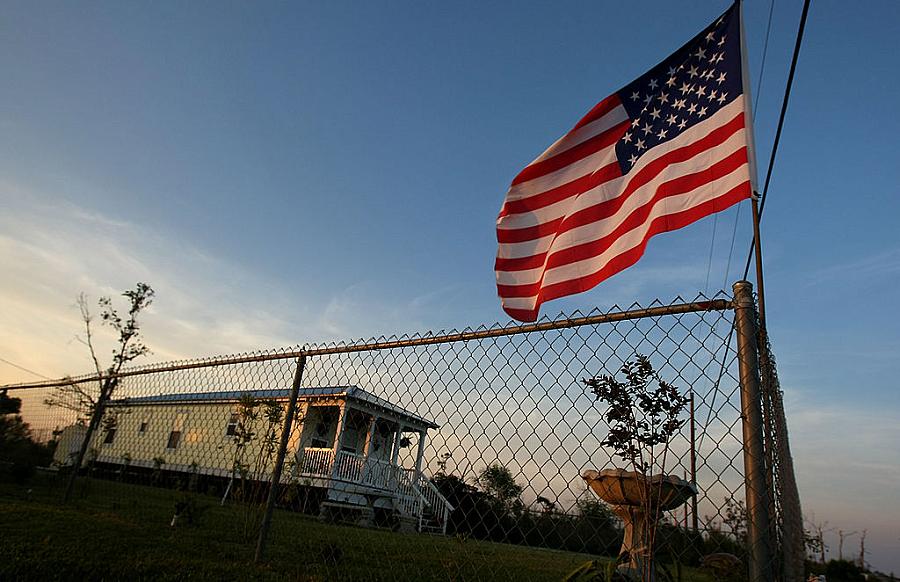Nearly 15 years after Katrina, children along Mississippi’s Gulf Coast face dire struggles

An American flag flies above a post-Katrina trailer in Waveland, Mississippi.
(Photo by Mario Tama/Getty Images)
By spring of 2018, Margaret Alfonso, the former youth court judge in Harrison County, couldn’t keep up with all of the cases. In her courtroom in downtown Gulfport, Mississippi, her assistant Cindy had set up a folding table. On it were scores of files, some stacked as high as two feet. All cases she’d be hearing this week. She worked at night, she worked on the weekends. So did Cindy.
“I’ve never seen it like this,” said Alfonso, who’s worked in some capacity of the Harrison County youth legal system since the 1990s.
In the last four years, the number of children in foster care in Mississippi’s three coastal counties has skyrocketed, reaching a peak in 2018 of 1,471 cases, or 27% of all cases in a region with just 12% of the state’s population. Harrison County alone had 837 of these cases.
For many in the state, the news was a shock. Mississippi’s Gulf Coast has long been the one stable region in a chronically impoverished state, anchored by strong military defense and tourism industries. Even after Hurricane Katrina decimated the area and a massive oil spill, just five years later, crippled fishing and tourism there, the coast seems to have chugged along. While a drive down coastal Highway 90 is dotted with vacant lots, signs of new life have also bloomed: casinos, restaurants and hotels, military outposts, fishing boats and white sand beaches.
Travel half a mile inland, though, and the landscape changes. Rambling seaside mansions give way to apartment complexes and parks where Katrina trailers still stand, 13 years after FEMA issued the temporary shelters. A 2018 economic report ranked the Mississippi Gulf Coast region 349 out of 383 national economies, the lowest of Mississippi’s four metropolitan areas. The coastal economy has not recovered.
And neither have its people. Drug use has skyrocketed and with it cases of child abuse and neglect. Mississippi’s coastal region leads the state in fatal overdoses. Alfonso estimated that 80% of her cases are drug-related.
“When the economy doesn’t recover, the people can’t recover. And when the people haven’t recovered, the economy can’t,” said Ashley Edwards, president of the Gulf Coast Business Council.
“You’re looking at a cycle.”
When it comes to Child Protection Services, poverty itself can be a factor. Back in Alfonso’s courtroom, she opens a file and takes out a series of pictures — what appear to be the remnants of a home. Paint is peeling. Leaves and debris litter the floor. The shelves of a refrigerator that hasn’t run in months are smeared with brown residue. Three children were removed from this home. The court calls these cases “economic neglect.”
“We’re seeing more and more homes with lack of utilities. We can’t leave children where there’s no running water and no power — there’s no way to keep them clean,” Alfonso said.
Next year marks the 15th anniversary of Hurricane Katrina. In the storm’s aftermath, the national narrative focused on the floods that swept New Orleans. But Mississippi bore the brunt of Katrina’s winds.
To rebuild, Mississippi received $30 billion in federal aid. The funding went to housing, infrastructure, commercial interests and economic development. When asked how much of the federal relief aid Mississippi steered to mental health services, Edwards of the Gulf Coast Business Council, said “I can’t think of any.”
Instead, Mississippians were denied access to tools such as the temporary Medicaid expansion extended to 9/11 victims. And later, as states around the country began to expand Medicaid, Mississippi declined, instead slashing its budgets for mental-health services to the bone.
Using the lens of mental health, my 2019 National Fellowship project — “Katrina’s Children” — will examine how Hurricane Katrina continues to affect the communities in Mississippi’s Gulf Coast a decade and a half after it first made landfall here.

